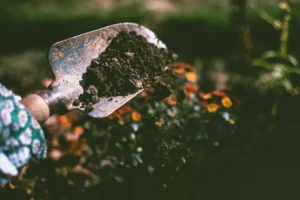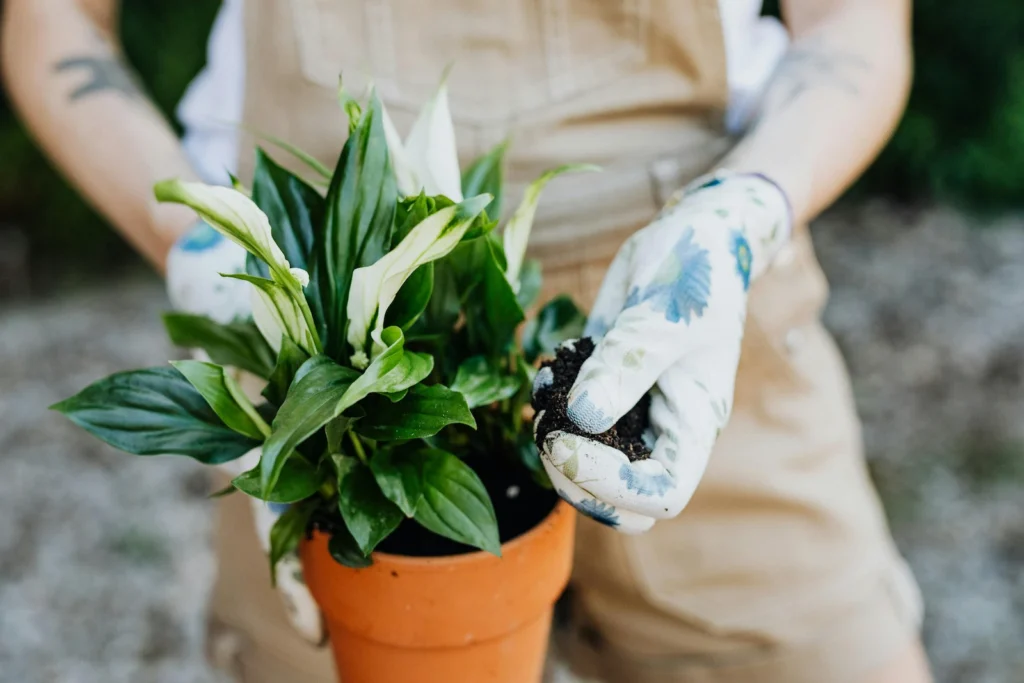
Choosing the right potting mix is significant for the health and growth of your peace lily. Whether it’s indoors as a houseplant or outdoors in the garden, the ideal soil composition for peace lilies should strike a delicate balance between moisture retention, drainage, aeration, and nutrient availability. A well-draining potting mix is the one that retains an appropriate level of moisture without becoming waterlogged. This prevents root rot and other problems associated with overwatering. Conversely, a soil mix that is too dense or compacted can hinder root development and lead to poor growth and health. Want to have a good foliage? Keep reading more.
Peace lily potting mix
Essential ingredients
Peat moss: Peat moss provides an absolutely wonderful water retention quality while also allowing for good aeration of the soil (you know plants breathe through their roots, right? 😉 ). It helps to keep the soil moist without becoming overly soggy.
Perlite or Vermiculite: Perlite or vermiculite are low density i.ei. In simple terms lightweight, sterile materials that improve soil drainage and aeration. They prevent compaction of the soil keeping free space amongst the roots and the soil which helps create a healthy root environment for the peace lily.
Coarse sand: Adding coarse sand to the potting mix further enhances drainage and prevents soil compaction. It helps to create air pockets in the soil, promoting root growth and preventing waterlogging. (Psst! Save yourself from root rot!)
Compost: Adding compost or well-decomposed organic matter enriches the potting mix with nutrients and beneficial microorganisms (sort of like probiotics for gut health, maybe?). It improves soil structure and provides essential nutrients for the peace lily’s growth and development.
Nutrients from the potting mix for peace lily
Now to go deeper into the science level of nutrients, let’s discuss some elements that needs to be in the potting mix
Nitrogen (N): Nitrogen is essential for promoting lush, green foliage growth in peace lilies. It plays a crucial role in photosynthesis, the process by which plants convert light energy into chemical energy to fuel their growth and development.
Phosphorus (P): Phosphorus is necessary for promoting strong root development and flowering in peace lilies. It aids in energy transfer within the plant and supports the formation of flowers and fruits.
Potassium (K): Potassium helps regulate water uptake and retention in plants, improving their resistance to drought and stress. It also plays a role in enzyme activation and overall plant health.
Calcium (Ca) and Magnesium (Mg): These secondary nutrients are important for maintaining proper cell structure and function in peace lilies. Calcium helps strengthen cell walls, while magnesium is a component of chlorophyll, the pigment responsible for photosynthesis.
Maybe you want to read more about turgor pressure too when it comes to strengthening cell walls.
Trace minerals: Like humans, plants like Peace lilies too require trace amounts of micronutrients such as iron, manganese, zinc, copper, and boron for various metabolic processes and enzyme functions. This doesn’t mean you have to go to a local pharmacist and buy supplements and crush it into the soil mix.
To provide these essential nutrients, you can incorporate organic matter such as compost or well-decomposed manure into the potting mix. These organic materials release nutrients gradually as they decompose, providing a steady supply of nitrogen, phosphorus, potassium, and other trace minerals.
Additionally, you can use slow-release fertilisers specifically formulated for indoor plants to supplement the nutrient content of the potting mix.
Read more about Best fertilizer for peace lily (Coming soon)
What kind of soil should be used for peace lily?
Let’s make a potting mix for peace lilies based on the above explanation. Take the following:
- 2 parts peat moss
- 1 part perlite or vermiculite
- 1 part coarse sand
- 1 part compost or well-decomposed organic matter
Now, if you are wondering what is one ‘part’ or two ‘parts’, don’t be confused. You can choose a container to use as your measuring tool. ‘Part’ here means the proportion of ingredients. This could be any container of your choice, such as a bucket, scoop, bowl, cup, or even a garden trowel. For example one bowl of peat moss, one bowl of perlite, etc. in the complete mix. You can scale up or down the size of your container depending on the quantity of potting mix you would need. For example, if you need a larger batch of potting mix, you might use a larger container like a bucket. If you only need a small amount, a smaller container like a cup or scoop would do.
Can I use cactus soil for peace lily?
While cactus soil is formulated specifically for the needs of cacti and succulents, it can sometimes be used for peace lilies as well, especially if you’re looking for a well-draining mix.
If you choose to use cactus soil for your peace lily, consider amending it with additional organic matter such as peat moss or compost to improve moisture retention. You may also need to adjust your watering routine to ensure that the peace lily’s soil remains adequately moist, as cactus soil can dry out more quickly. But in general, put some efforts and prepare a good mix, please.
Alternatives to Peat moss, Vermiculite, Perlite
If you are having trouble finding some of these materials, you can try some alternatives. You don’t find a laboratory condition in the wild for these plants to grow on their own, so you can definitely modify certain things. For peat moss you can use coco peat or coconut coir, Sphagnum moss, pine bark, leaf mould, kitchen scraps, yard waste, and plant matter. Also for perlite and vermiculite, you can use pumice, rice hull, rice husk ash, coconut coir (again!) as an alternative. For alternative to soil, get soil only. At least don’t expect an alternative here for that.
Peace lily bugs in soil
Fungus gnats: Fungus gnats are small, dark-coloured flies that are commonly found in moist soil. They lay their eggs in the soil, and the larvae feed on organic matter and plant roots, potentially causing damage to the peace lily.
Solution for fungus gnats?
a. To control fungus gnats, allow the soil to dry out between waterings, use sticky traps to catch adult flies, and avoid overwatering the plant.
- Place yellow sticky traps near the peace lily to catch adult fungus gnats. The bright yellow colour attracts the gnats and they tend to stick to the tape. Replace the traps regularly to maintain effectiveness.
- Introduce beneficial nematodes that feed on the larvae of certain fungus.
- Sprinkle a thin layer of diatomaceous earth on the surface of the soil. This dehydrates the moisture on the skin of fungus gnats
- Neem oil is a natural insecticide derived from the neem tree. Neem oil disrupts the growth and development of fungus gnat larvae and can help reduce their population over time.
Springtails: Springtails are tiny, wingless insects that feed on decaying organic matter in soil. While they typically don’t cause significant harm to plants, their presence in large numbers can be unsightly. To control springtails, allow the soil to dry out slightly between waterings and avoid overfeeding the plant with organic matter.
Root mealybugs: Root mealybugs are small, white, waxy insects that feed on the roots of plants, including peace lilies. They can cause stunted growth, yellowing leaves, and wilting. To control root mealybugs, inspect the roots of the peace lily for signs of infestation, remove any affected roots, and treat the plant with a horticultural oil or insecticidal soap.
Ants: Ants are attracted to peace lily soil for various reasons, such as seeking food or shelter. While ants themselves may not directly harm the plant, they can protect and farm other pests such as aphids or scale insects. To deter ants, remove any food sources from the vicinity of the plant, seal any entry points into the pot, and use ant baits or barriers if necessary.


